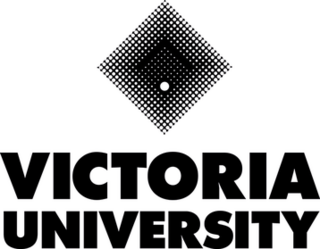Related Research Articles
Technical and further education or simply TAFE is the common name in English-speaking countries in Oceania for vocational education, as a subset of tertiary education. TAFE institutions provide a wide range of predominantly vocational courses.

Victoria University is a public research university based in Melbourne, Victoria, Australia. It is a dual-sector university, providing courses in both higher education and technical and further education (TAFE).
La Trobe University is a public research university based in Melbourne, Victoria, Australia. Its main campus is located in the suburb of Bundoora. The university was established in 1964, becoming the third university in the state of Victoria and the twelfth university in Australia. La Trobe is one of the Australian verdant universities and also part of the Innovative Research Universities group.

RMIT University, officially the Royal Melbourne Institute of Technology, is a public research university in Melbourne, Australia.

Bundoora is a suburb in Melbourne, Victoria, Australia, 15 km (9.3 mi) north-east of Melbourne's Central Business District, located within the Cities of Banyule, Darebin and Whittlesea local government areas. Bundoora recorded a population of 28,068 at the 2021 census.

Preston is a suburb in Melbourne, Victoria, Australia, 9 km (5.6 mi) north-east of Melbourne's central business district, located within the City of Darebin local government area. Preston recorded a population of 33,790 at the 2021 census.

Reservoir ( "REZ-ə-vore") is a suburb in Melbourne, Victoria, Australia, 11 km (6.8 mi) north of Melbourne's Central Business District, located within the City of Darebin local government area. Reservoir recorded a population of 51,096 at the 2021 census.
Melbourne Polytechnic, formerly NMIT, is an institute of higher education and vocational education (TAFE) located in Melbourne, Australia that has been operating since around 1910.
John Wardle is a Melbourne-based architect. He graduated from the Royal Melbourne Institute of Technology with a degree in Architecture.

RMIT University Library consists of six academic branch libraries in Australia and Vietnam. Its four Australian branches are located on the RMIT University campuses in Melbourne City, Bundoora and Brunswick; and its two Vietnamese branches are located at the RMIT University Vietnam campuses in Ho Chi Minh City and Hanoi.

The Emily McPherson College of Domestic Economy was an Australian domestic science college for women, in Melbourne, Victoria.
The Royal Melbourne Institute of Technology (RMIT) is an Australian public university, founded by Francis Ormond MLA in 1887, in Melbourne, Victoria, Australia.
The Melbourne City campus of the Royal Melbourne Institute of Technology is located in the city centre of Melbourne in Victoria, Australia. It is sometimes referred to as "RMIT City" and the "RMIT Quarter" of the city in the media.

Thomas Lenton Parr AM was an Australian sculptor and teacher.
The RMIT School of Accounting is an Australian university business school located in Melbourne, Victoria, which is responsible for undergraduate and postgraduate education and research in accounting at RMIT University. The School was established in 1943 and its name was changed to the School of Accountancy in 1948.
The RMIT Redbacks are the sport collective of the Australian research University the Royal Melbourne Institute of Technology (RMIT), based at all campuses in Victoria and Ho Chi Minh City, Vietnam. The program is managed by the RMIT Sport team, part of RMIT Student Life.

Percy Edgar Everett,, was appointed chief architect of the Victorian Public Works Department in 1934 and is best known for the striking Modernist / Art Deco schools, hospitals, court houses, office buildings and technical colleges the department produced over the next 20 years.

Education in Melbourne may be divided into four groups: pre-school, primary education, secondary education and tertiary education. Melbourne is home to some of Australia's largest university and prominent independent schools. Entry to tertiary education for most students is through the Victorian secondary school system where students are ranked by the Australian Tertiary Admission Rank (ATAR) upon completion of Year 12.
Richard Laurence Broome, is an Australian historian, academic, and emeritus professor of history at La Trobe University, Melbourne. He is known as an authority on Aboriginal history in Australia.
Jean Hagger was an Australian librarian, professional educator in librarianship and indexer. She was the foundation Head of the Department of Librarianship at the Royal Melbourne Institute of Technology (RMIT), Melbourne and the first female Head of Department in the same institution. She has been referred to as "a pioneer of education for librarianship in Australia".
References
- ↑ "Phillip Institute of Technology". Research Data Australia. Retrieved 5 April 2020.
- ↑ "About". Coburg teachers' college reunion and history 1963-66. Retrieved 5 April 2020.
- ↑ "Melbourne Polytechnic - Our History". Melbourne Polytechnic. Retrieved 5 April 2020.
- ↑ "Newlands | Victorian Places". www.victorianplaces.com.au. Retrieved 5 April 2020.
- ↑ "About". Coburg teachers' college reunion and history 1963-66. Retrieved 5 April 2020.
- ↑ "Phillip Institute of Technology". Research Data Australia. Retrieved 5 April 2020.
- ↑ Denhoim, Carey; Peter Ling (1990). "Australian Child and Youth Care: Developments in Education and Training". Journal of Child and Youth Care. 4 (4). Archived from the original on 21 July 2011. Retrieved 28 March 2011.
- ↑ "Victorian Women's Honour Roll" (PDF). Victorian Government. 2002. Archived from the original (PDF) on 28 March 2011. Retrieved 28 March 2011.
- ↑ "Phillip Institute of Technology".
- ↑ Carroll, Brian (1995). A decade of achievement : Phillip Institute of Technology. Abbotsford, Vic.: RMIT Press. p. 218. ISBN 0-7306-8752-X.